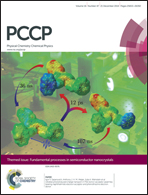Controlling the orientations of gold nanorods inside highly packed 2D arrays†
Abstract
Gold nanorods (AuNRs) were assembled into highly packed two dimensional (2D) arrays with different structures by the Langmuir–Blodgett (LB) technique. The structure of the 2D arrays (the width of the arrays, the surface area and the shape of circular voids) was controlled by varying the applied surface pressure in the LB trough. Due to the shape anisotropy of AuNRs, both end-to-end (EE) and side-by-side (SS) assembly were observed depending on the chain length of a polyethylene glycol (PEG) polymer functionalized with their surfaces. Short chain PEG encouraged the SS assembly of the AuNRs, while the SS and EE assemblies were obtained in case of using the long chain PEG. Numerical calculation of the potential energy between two nanorods as a function of separation and orientation yielded good predictions of the optimum separation distance between the nanorods and their orientations inside the arrays. Due to the alignment of the AuNRs inside the arrays, optical measurements of the arrays showed a strong longitudinal localized surface plasmon resonance (LSPR) peak when excited by polarized light along the axis of the majority of the rods. When the polarization angle was rotated by 90 degrees, the intensity of the high energy transverse LSPR peak was increased. The measured LSPR spectrum of the arrays was confirmed by discrete dipole approximation (DDA) calculations, which was used to simulate both the LSPR spectrum and the plasmon field distribution.


 Please wait while we load your content...
Please wait while we load your content...